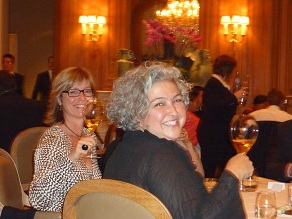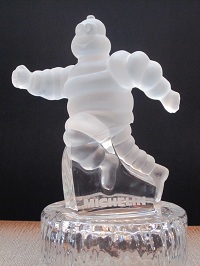The French adore the word “pedagogical”. It means educational, but really, it seems it means much more than that. Our final “pedagogical” dinner, and final dinner is at the two star Michelin Les Crayeres in Reims. The previous chef here was one of the founders of our diploma program, and he has passed on the reins to young Philippe Mille. This dinner is dedicated to the art of wine and food paring – and a “tres grand fromage”(a really big cheese, that’s student lingo, nothing official) in the world of wine has been brought in to provide instruction, “pedagogy”. I get to sit right next to him. Good thing too, thought I knew a thing or two about wine. Wrong. That’s ok – I am here to learn – pencil at hand.
Act I
We start with a Cuvee Orbaciac – Chenin Moelleux 2009 – yes it is young – a child really – but we are told that even in it’s youth we can dream of what glory it will bring in thirty years. Moelleux refers to the heavy ripeness of the fruit when it was picked. It is from a small vineyard in the Languedoc – land recently reclaimed by a group comprising of a doctor, a lawyer, a businessman – all under the tutelage of the wine instructor sitting to my right. His wife informs me that he is the “father” of Chenin Blanc without him it would be dead. “This is terroir. Land, soil, place and the act of man. “ These men having been working hard – reclaiming a vineyard once devastated by Phylloxera ( a deadly disease in the 1860’s that decimated vineyards across France – you can only say the word “Phylloxera” with a look of disdain on your face). It looks like their hard work is going to pay off. I should mention that while we are enjoying this “baby”, small tranches of grilled bread topped each with a perfect slab of foie gras almost a centimetre thick are being passed around. The combination is pure perfection, the richness of the foie (the barely there bread merely a carrier) and the ripeness of the fruit in the wine…I may have had three tranches…ok, it was four, but this was my last night in Reims….
Act II
Next up is a 2007 Meursault Genevieres 1er Cru, from Bouchard Pere & Fils. Here’s where I make my FIRST faux pas of the evening. It was not pretty. In an effort to make pleasant conversation, I lean over to “M. Grand Fromage of Wine” (MGFW) and remark that the “cepage” (variety) is Chablis…non? (OK, I thought I’d score a point or two, knowing my varietals, and which come from what region in France) Well, you’d think I had asked for ketchup to drizzle on top of my foie.
Cepage? What is the obsession with cepage North American’s have? “If you like a concerto by Mozart, do you ask what the percentage of violin was in the composition? What the ratio was of French horn?” You must enjoy the wine in its entirety – not dissect it grape by grape. The soil. The sun. The work of man. Admire the craft. Breaking down into varietal is overlooking the entire point.
Promise. Never. To. Ask. Re. Cepage. Again.
During this cepage debate we enjoy the most incredible dish of wild mushrooms, with a hint of garlic, “sot-l’y-laisse”, the slightest hint of cream and a drizzle of roasted hazelnut oil. Joy! “Sot-l’y-laisse” translates into “only the fool leaves behind”, and they are the little morsels on the back of the chicken that my family always referred to as the oysters. The part I always caught my dad noshing while carving – hoping nobody would see. It is served in a bowl with a spoon. It is rustic yet incredibly elegant all at once.
Intermezzo

Between courses I am asked where I am from. When I reveal Canada, I am told that our ice wines are very good, but maybe we should stop there. Anything else might be a waste of time. There is some hope for California, but it takes a vineyard three centuries before any good wine can be made. MGFW smiles kindly at me.
Act III
For the main we are having a “lacquered” duck with cous cous. To accompany 1999 Chateau Margaux. The King of Bordeaux. Please, do not ask me what varietals make this incredible wine. Google it – I did not ask. I smell the wine. Rich in tannins notes of tobacco, leather. I smell the duck – soy, star anise, cinnamon. I am a little nervous about this combination – but what do I know?
We had a lecture on terroir last week, from a geographer’s perspective, explaining how and why the vineyards of France are where they are. Essentially vines were planted close to the city centres, close to the big churches, and close to markets that wanted to buy wine. The esteemed vineyards of Bordeaux were planted in order to meet consumer demand and reduce transportation as much as possible. No searching around for the right slope, the right exposure, analyzing mineral content of soil. Just pure old fashioned supply and demand. Were they just lucky? Or did they figure out how to make something wonderful with what they had to work with? And if the latter is true, then what about this notion of terroir? Isn’t the hand of man the determining factor? We have all discussed this at length and I am on the verge of asking MGFW, but when I look over at him, I chicken out…”sot-l’y-ask”(only the fool asks).
Turns out the match was perfect. The spiciness of the wine and the intense flavours of the duck, simply become one in your mouth – complimenting each other. And the compliments flow like poetry for this bottle:
“This wine was an animal in another life!!” exclaims a delighted taster.
“We are in a Baroque Opera, everyone says what they say and that is it!”
“We are not sad, this wine is smiling and brings happiness!”
And for the chef:
“This is the work of a chef who is both calm and reasonable”
Final act. Wait for it. I still can’t believe it.
Chateau D’Yquem 1998. Seriously. Truth be told, I am not a big swirler when it comes to wine. You know – sliding the glass around on the table and taking a big whiff before tasting. I always smell, but with little flourish and swirl. I feel the grand environment and the fact that it is Chateau D’Yquem in MY glass, and we may never meet again, and decide to swirl LARGE!
“STOP!”
“Be patient. What is your rush? This is one of the most precious wines in the world” MGFW smiles gently at me, like you would with a child you know does not know any better. It must be very difficult when you are a wine god to have to explain everything to some gal from the wilds of Canada.
First, you must hold the glass up to the sky and admire its beauty, its colour, its richness, and the “meniscus” (no, not the “legs”, but the curve of the surface of the wine in the glass). The colour is that of pure amber, and apparently amber is the colour of wisdom.
Then, you smell, without a single hint of swirl. “It does not get better than this.”
Only then you may swirl, gently, and inhale the beauty of the wine. “Yquem needs nothing”
Lastly, but hardly least, small sips. Tiny sips. MGFW tells us that if this liquid gold could speak, it would say “I am the lord, and I bless everyone.”
As if any dessert is needed, what with the treasure each of us has before us, we are presented with undoubtedly the most splendid dessert I have yet to encounter.
Imagine. It looked like a pear covered in white laquer. The server poured a luscious salted caramel sauce over top, and you watched it slide down the sides into a pool. You literally “cracked” the white candy lacquer, to find a caramel cream and no pear at all. As you “dug” through the cream, you came upon a heart made of pear ice cream and delicate cake. It was enchanting. “This is not a stupid chef!”
And so our gastronomic pedagogical “opera” came to an end. I thanked MGFW for sharing his wisdom, and assured him I had learned my lessons for the evening, waving my notes in the air. He seemed pleased. And I was beaming, aglow in Yquem…….
